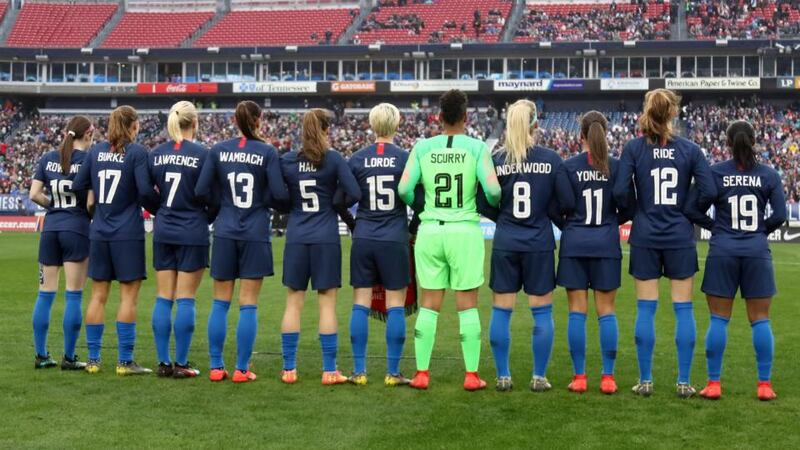When the US national team took on England in the SheBelieves Cup in Nashville earlier this month, every player in the squad wore the names of women who inspired them on the back of their shirts. A nifty idea, the diverse selection included groundbreaking luminaries like Malala Yousafzai, Serena Williams, Supreme Court Justice Ruth Bader Ginsburg, and astronaut Sally Ride.
However, sub goalie Ashlyn Harris garnered the most headlines when she opted for Cardi B, the stripper turned singer whose hit song I Like It contains the lyrics; "Now I like dollars, I like diamonds
I like stunting, I like shining
I like million dollar deals
Where's my pen? Bitch, I'm signin'"
The perfect soundtrack for what came next. Six days later, Harris and her teammates put their names to a lawsuit citing gender discrimination by the United States Soccer Federation (USSF) and demanding equal pay with their male counterparts. That they filed the papers on International Women’s Day was no accident.
Here is a group who have been battling their own governing body for years, pursuing parity of esteem (they have been regularly forced to play matches on astroturf fields), as much as closing the salary gap. That they chose to do so just three months out from the start of the Women’s World Cup in Paris was deliberate too, a reminder of their global stature in the sport.
We believe it is our responsibility, not only for our team and for future US players, but for players around the world – and frankly women all around the world – to feel like they have an ally in standing up for themselves
The USA are the reigning world champions and their victory over Japan in the 2015 decider was the most-watched televised soccer match in American history. Four-time Olympic champions, they have been ranked the best distaff team on the planet for 10 of the last 11 years and, in terms of on-field achievement, revenue and profit, they have contributed more to the USSF than their male counterparts over the past two decades. Yet, the ongoing quest for equality can be traced all the way back to the pioneering Mia Hamm and Brandi Chastain generation of 1999. The wheels of progress grind that slow.
"I think to be on this team is to understand these issues," said Megan Rapinoe in the New York Times. "And I think we've always – dating back to forever – been a team that stood up for itself and fought hard for what it felt it deserved and tried to leave the game in a better place. We very much believe it is our responsibility, not only for our team and for future US players, but for players around the world – and frankly women all around the world – to feel like they have an ally in standing up for themselves, and fighting for what they believe in, and fighting for what they deserve and for what they feel like they have earned."
The numbers they cite in their deposition are stark. For reaching the second round of the 2014 World Cup in South Africa, Jurgen Klinsmann’s squad received performance bonuses totalling $5,375,000. When Rapinoe bulwarked the women’s team that captivated the nation and brought home the trophy 12 months later, their reward was to be given $1,725,000 and then to be dispatched on a money-spinning nationwide 10-game victory tour.

Suddenly, a projected USSF loss of $430,000 for that year turned into a $17.7 million profit. According to the present pay scale, a female international will still earn 38 per cent of what her male equivalent takes home for representing their country in the same amount of games in a calendar year.
The USSF will argue that comparing the men and women's teams is not comparing like with like. For starters, while Christian Pulisic et al make most of their living from their clubs, all the female players are centrally contracted to the governing body here, in the same way the IRFU owns the contracts of Ireland's rugby internationals. To their credit, the USSF were the first association to take that revolutionary step and it's remained necessary because the current National Women's Soccer League (NWSL) is the country's third attempt at maintaining a financially viable professional women's competition since 2001.
There's some merit to their defence, except Alex Morgan, whose name you will see on the back of as many shirts as any European star around American schoolyards, is on a base pay of around $126,000. Even if that sum usually more than doubled with bonuses, it hardly reflects what she is worth to the USSF in terms of her profile off the field, never mind her stellar contributions on it. Morgan was one of the quintet of stars who started this latest phase of the legal battle when they filed a discrimination case with the Equal Employment Opportunity Commission in March, 2016.
Three years down the line, all 28 members of the current squad are signed on this time around and the struggle has now entered a more serious phase, even as the American team is in a rather curious place in its own evolution. Their triumph at the inaugural World Cup in 1999 was at least in part down to Title IX, the visionary 1972 legislation that forced every school and college in the nation to invest properly in female sport. That gave the US a serious advantage over their rivals but, after so long as the gold standard, there’s a growing sense plenty of other countries are catching up and doing so by playing a more sophisticated brand of football.
If that’s true, the time for these women to strike is now.













